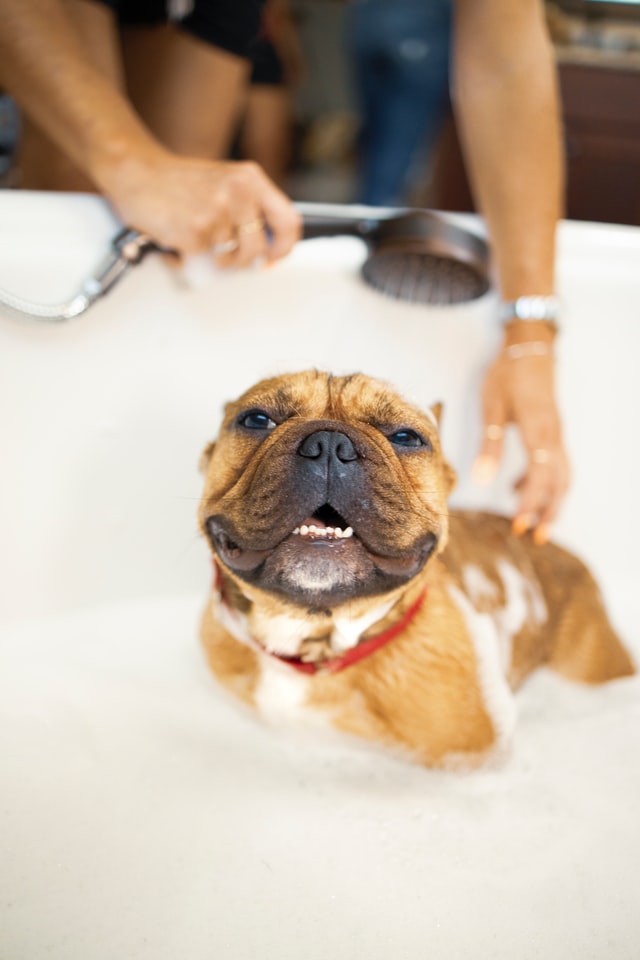How To Give Your Dog A Bath
Posted: 11/06/2023 | BY: Lacy Bursick | Categories: Uncategorized
Giving your dog a bath is either a bonding moment or a challenge. In fact, I can remember very clearly the first time I gave my 10-year-old dog her first bath. We had just gotten home from the shelter I adopted her from in Indiana, which was a barn. She smelled like a barn animal and using puppy dog shampoo, I had to wash her like 7 times before the stank finally washed away. She was very scared and confused, but I do believe during that moment, she understood I took care of her now.
Now 10 years later, if I tell her it’s time for a bath, she will jump into the bathtub and patiently wait until she is clean and receives a treat. She will even come back into the bathroom after getting her post-bath zoomies out to get her hair blow-dried.
Now I know not all dogs will accept bathtime, in fact, my small dog who is age 4 still has a panic attack with full-body shakes until his bath is over, every time. No amount of treats in the world will ever make him accept bath time.
How Often Should You Bathe A Dog?
No matter how your dog reacts to baths, it is recommended that you bathe your dog monthly. This keeps their skin and fur healthy, keeps them pest-free, and reduces the chances of other issues such as fungal infections.
You do not need to give your dog a bath more than once a week, but there can be times that are exceptions such as they rolled in something gross. Keep in mind that over bathing your dog can make their skin dry out.
How Old Should My Dog Be To Give Them A Bath?
If you have adopted a puppy, you should be extra cautious of water temperatures, and mostly wipe them with a wet cloth. Puppies are supposed to be bathed by their mothers. If your puppy is over 8 weeks, you can introduce it to the bathtub or sink, and try to make it an enjoyable experience, always rewarding a treat at the end.

What Should I Use?
When you are preparing to give your dog a bath, you will want to use dog shampoo. Dog shampoo is specially formulated for dogs and is less likely to burn their eyes. There are various methods to giving your dog a bath, but I have found placing them in the bathtub with an adjustable shower head works best for my dogs. Small dogs can easily be bathed in the sink, and large dogs may need to be bathed in a special dog wash or even outside with a hose.
Whatever method you choose, you always be conscious of the water temperature, the room or outside temperature, and always have a towel ready to go.
You will want to have the dog shampoo ready to go, and the best method is to dampen your dog’s fur first, then lather in the shampoo. Be careful around the eyes, nose, face, ears, and mouth. In fact, I do not use soap in these areas, just a damp washcloth or towel. Just as it burns when you get soap in your eyes, it will burn your dog’s eyes too, making your dog hate bath time even more.
When you have rinsed off all the soap, you will want to dry your dog the best you can with a towel. After I towel dry them, this is when I reward them with a treat. My dog knows that after each bath she is rewarded and it has truly helped her get used to bathtime.
Once you are done, you can also try to dry your dog with a hairdryer. Some dogs will react better than others to this. My dog actually enjoys it because it warms her up. Just remember to keep the hairdryer back away from their skin so you don’t burn them, and keep it on a low heat setting.
Even if you adopt an older dog who has never had a bath, don’t get discouraged. With patience and love, your dog can adjust to bathtime too. Just try to always reward them every time you give your dog a bath and make it as enjoyable of an experience as you can.
Alternatively, you can also have your dog professionally groomed, which sometimes is necessary. Professional groomers will have tools that you don’t have at home, which can help tremendously.
Happy bathing!
Since you love your pet, don’t forget to get pet insurance so you know they are covered with the best care options all the time.
DisclaimerThe information contained on this blog is intended for informational and educational purposes only and should not be construed as medical advice. It is not a substitute for professional veterinary care. Always consult with your veterinarian before making any changes to your pet's health care or treatment plan.
The authors of this blog are not veterinarians and do not claim to be experts in pet health. The information provided here is based on our own experiences and research, as well as information from reputable sources. However, we cannot guarantee the accuracy or completeness of this information.
We encourage you to do your own research and consult with your veterinarian before making any decisions about your pet's health.
Previous post
10 Instagram Famous Dogs You Should Be FollowingNext post
Coping with the Loss of a PetCompare top pet insurance providers plans.
Enter your dog’s age in years and months to calculate their age equivalent to human years.
Calculate your dog’s ageEnter your cat’s age in years and months to calculate their age equivalent to human years.
Calculate your cat’s age